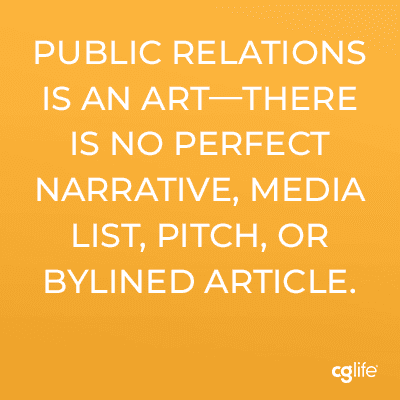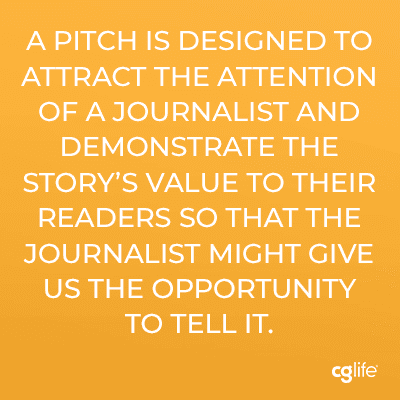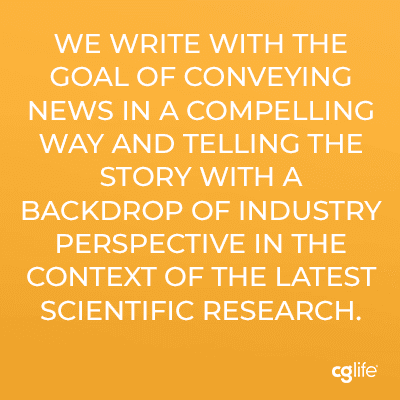

From Narrative to Story: How We Do Public Relations
So, here we are, two scientists working for a marketing communications agency in the public relations department.
We both received our doctorates in the biological sciences from the University of Chicago before we left academia to pursue careers in science communications. While some might not see any overlap between working in an academic lab and working in an office, we found some interesting parallels. For instance, after exclusively socializing with other scientists for many years while in school, we took for granted that everyone understood the scientific concepts we had studied. After transitioning to our roles in the Public Relations department at CG Life, we discovered a disconnect.
While we live and breathe media pitches, narratives, and story angles every day, not everyone shares the same media relations background that we do; others might come at media relations from a different perspective, whether it’s advertising, finance, or business management, and may interpret concepts differently than we do.
To level set, we thought we’d explain our approach to the public relations process. We’ve landed client interviews and article coverage in publications such as The Wall Street Journal, Bloomberg News, Science, and Scientific American, which shows that our process works. But unlike following a protocol to run a laboratory experiment, public relations is an art—there is no perfect narrative, media list, pitch, or bylined article.


Below, we describe the four steps we take to transform an idea or product into a story that generates visibility for our clients. As you’ll see, our process begins as highly conceptual and as we get closer to a finished article or interview, we add details to create an engaging and informative piece of content.
1. Develop a Narrative
Building a narrative is the first step in transforming our clients’ products, events, and other news into stories. This internal sandbox enables us to build a framework of ideas and test them with our clients without interference from the media.
Narratives are not designed to be seen by journalists and therefore do not need to be perfectly written. Rather, the narrative helps us consolidate the information we have in front of us—the messaging and positioning documents, whitepapers, peer-reviewed articles, brochures, sales decks, etc.—into a flowing story that summarizes the challenge our client’s audience is facing and the solution our client has to offer. It forms the guiding document that helps us plan our media relations strategy for a particular campaign.
2. Construct a Media List
The next step in the PR process is developing a media list. One of the primary challenges in media relations is learning how to target the appropriate messages to the right reporters at relevant publications. As we described earlier in “5 Steps to Get Editors Calling You,” reporters are only going to respond positively to a pitch if the content and intent align with the topics that the reporter covers and that appeal to their readers.
To maximize pitch success, we develop a media list. We often assemble a general media list that can serve us across more than one client and that remains accurate for years. The general media list acts as a template for generating tailored media lists for specific news announcements or campaigns. Our media targets will change as we pitch different narratives, as well. Sometimes we determine that a journalist who we thought would be a good target no longer fits our message, and other times we find a new angle that would appeal to a journalist who we didn’t think applied before.
Overall, the key to a strong media list, as with a strong pitch (as you’ll see below), is customization. Where we send a pitch is always based on knowledge of what that particular journalist covers. Even within the same publication, journalists cover different beats, so we often research their recent writing to determine if a pitch fits. If it doesn’t, the journalist might note that we didn’t do our homework and put us on their blacklist, even if we come back with a great idea in the future. Therefore, we review our media lists and journalist preferences constantly to ensure that we are up to date and appropriately targeted


3. Write Pitches
The pitch is where we start getting more specific about the content we eventually want to publish in the media. After developing a narrative, we use it to generate one or more pitches that explore different aspects of a story or address journalists who cover different topics. Like narratives, pitches are also conceptual documents. They indicate the direction the story will eventually take, but not necessarily the specific path it will follow.
We’ve covered what makes a strong pitch in a previous blog post. The important thing to note here is that a pitch is a malleable document that changes constantly depending on the needs of a particular journalist or publication. The first pitch we write is rarely the one we send because, as mentioned above, we continually modify each pitch to appeal to the specific backgrounds and previous coverage of each journalist. Thus, what we write in our pitch generally won’t even make it to the pages of a publication.
The bottom line is that the audience for a pitch is different from the audience for an article. A pitch is designed to attract the attention of a journalist and demonstrate the story’s value to their readers so that the journalist might give us the opportunity to tell it. Conversely, the goal of an article is to inform and educate a publication’s readers. Therefore, we often frame the story slightly differently when pitching a journalist compared to when we get the chance to speak directly to an audience of scientists and business leaders.
If an editor responds to our pitch, they sometimes ask for small tweaks to our proposed storyline to better cater to their audiences. We act as intermediaries until our clients are satisfied that the story the media has requested is the one they want to tell. Then, the writing begins.
4. Generate Bylined Content
When we get the opportunity to write bylined content, i.e., ghostwrite on behalf of our client’s subject matter experts, we finally get a chance to share our clients’ messaging, case studies, and industry insights with the world. At this stage, we solidify our approach. Brainstorms about messaging and story angles transform into discussions of grammar, syntax, and flow.


We write with the goal of conveying news in a compelling way and telling the story with a backdrop of industry perspective in the context of the latest scientific research. Depending on how familiar we are with the topic at hand, we might put together an outline and interview a subject matter expert to gather as much detailed knowledge as possible. We write a draft and then send it to our content team to review for readability and accuracy. Then, it goes to our client. Typically, the subject matter expert who will be listed as the author of the article will review it to ensure that every word accurately represents their perspective. Occasionally, other writers within CG Life will review the article to verify that it aligns with company messaging and quality standards.
At the editing stage, precision is key. We encourage our clients to edit as much as is needed until they are fully satisfied with the content. We always save and file our clients’ edits so we can learn from them and ensure future drafts are closer to what they’re looking for.
Finally, the article goes to the publication. Sometimes the publication accepts the article right away, while others might send us a PDF proof to check for any typos or formatting issues. And, when editors make their own edits, we manage the back-and-forth. After we finish up our edits, we wait until the article publishes—anticipating that it could take months, depending on the publication’s schedule.
Editors are often able to inform us of the exact publication date, while others cannot because they don’t have a defined publication schedule—they fit our article in whenever there is room in the publication, and it might be up to us to keep checking in to identify the date our article hits the web.
As we work with our clients, our goal is to have multiple opportunities cooking at any given time. By continuously identifying, managing, and pursuing various stages of the narrative, pitch, writing, and editing processes, often across several storyline narratives simultaneously, we can ensure that our clients are putting out a steady drumbeat of earned media placements that solidify their place as leaders in their fields.
